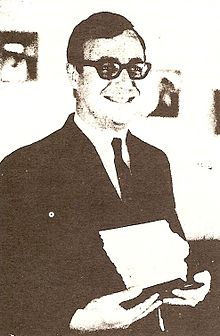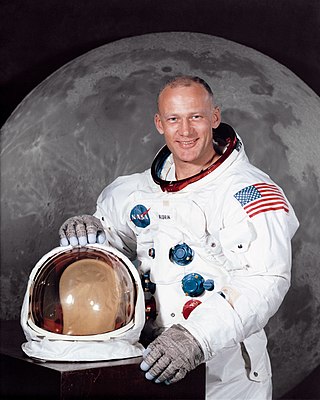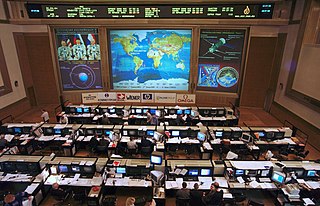
Steve Bales (born October 7, 1942 [1] ) is a former NASA engineer and flight controller. He is best known for his role during the Apollo 11 lunar landing.

Steve Bales (born October 7, 1942 [1] ) is a former NASA engineer and flight controller. He is best known for his role during the Apollo 11 lunar landing.
Bales was born in Ottumwa, Iowa, and grew up in the nearby town of Fremont. His father was a school janitor and his mother was a beautician. From a young age he had an interest in space and at the age of 13 he was deeply affected by a Wonderful World of Disney television show that discussed the future of space travel. "This show," he said later, "probably more than anything else, influenced me to study aerospace engineering. And this wasn't the ordinary thing to do for a boy raised in a small Iowa farming community." [2]
He graduated from Iowa State University with a Bachelor of Science degree in Aeronautical Engineering and was hired by NASA in December 1964. [3]
At NASA he was assigned to work in the Flight Dynamics branch as a guidance officer, a flight controller responsible for determining the location of the spacecraft in space and monitoring the guidance systems on board. He was a backup controller for Gemini 3 and Gemini 4 and worked his first mission as a flight controller on Gemini 10 when he was only twenty-three. [4]
Bales is best known for having been guidance officer (or GUIDO) during the Apollo 11 lunar landing when he had the responsibility of dealing with several problems that could have ended the mission. While monitoring the lunar module's position and velocity he came close to calling an abort when it became clear a navigational error had occurred. The spacecraft was moving 20 feet per second (6 m/s) faster than it should have been and was halfway to its abort limits. However, Bales continued to watch the data and the situation remained stable.
The last few minutes of the landing were punctuated by program alarms from the guidance computer. These alarms signalled an "executive overflow" which meant the computer might not be keeping up with its computing tasks. Bales had to very quickly determine whether this was serious. If high-priority computing tasks were indeed not being completed, he would have to call for an abort of the lunar landing. After several seconds had passed, he informed flight director Gene Kranz that the landing could continue despite the alarms.
While Bales is sometimes credited with having made the decision on his own, [5] like all flight controllers he was supported by a team of "backroom" engineers. 24-year-old computer specialist Jack Garman first recognized the meaning of the alarm and determined the situation was acceptable. As Bales said later, "Quite frankly, Jack, who had these things memorized said, 'that's okay', before I could even remember which group it was in". [6] The final decision of whether to call an abort (or in JSC jargon, "no go on the alarms") lay wholly with Bales, along with the responsibility if anything went wrong.
Bales' decision as GUIDO to go ahead with the landing was appropriate and Apollo 11 landed safely. When President Richard Nixon awarded the Presidential Medal of Freedom to the three Apollo 11 astronauts, Bales was also honored by being chosen to accept a NASA Group Achievement Award on behalf of the entire mission operations team. Nixon said at the time, "This is the young man, when the computers seemed to be confused and when he could have said Stop, or when he could have said Wait, said, Go." [7]
Bales had a long subsequent career at NASA and eventually became Deputy Director of Operations at the Johnson Space Center in Houston, Texas. In 1996 he left the space agency and took a position at Amspec Chemical in New Jersey. [8]
Bales was played by Andy Milder in the 1998 HBO miniseries From the Earth to the Moon . He was also interviewed in the History Channel documentary Failure Is Not an Option, the NOVA documentary To the Moon and BBC World Service podcast 13 Minutes To The Moon.

Apollo 11 was the American spaceflight that first landed humans on the Moon. Commander Neil Armstrong and Lunar Module Pilot Buzz Aldrin landed the Apollo Lunar Module Eagle on July 20, 1969, at 20:17 UTC, and Armstrong became the first person to step onto the Moon's surface six hours and 39 minutes later, on July 21 at 02:56 UTC. Aldrin joined him 19 minutes later, and they spent about two and a quarter hours together exploring the site they had named Tranquility Base upon landing. Armstrong and Aldrin collected 47.5 pounds (21.5 kg) of lunar material to bring back to Earth as pilot Michael Collins flew the Command Module Columbia in lunar orbit, and were on the Moon's surface for 21 hours, 36 minutes before lifting off to rejoin Columbia.

The Apollo program, also known as Project Apollo, was the United States human spaceflight program carried out by the National Aeronautics and Space Administration (NASA), which succeeded in preparing and landing the first humans on the Moon from 1968 to 1972. It was first conceived in 1960 during President Dwight D. Eisenhower's administration as a three-person spacecraft to follow the one-person Project Mercury, which put the first Americans in space. Apollo was later dedicated to President John F. Kennedy's national goal for the 1960s of "landing a man on the Moon and returning him safely to the Earth" in an address to Congress on May 25, 1961. It was the third US human spaceflight program to fly, preceded by the two-person Project Gemini conceived in 1961 to extend spaceflight capability in support of Apollo.

Apollo 13 was the seventh crewed mission in the Apollo space program and the third meant to land on the Moon. The craft was launched from Kennedy Space Center on April 11, 1970, but the lunar landing was aborted after an oxygen tank in the service module (SM) ruptured two days into the mission, disabling its electrical and life-support system. The crew, supported by backup systems on the lunar module (LM), instead looped around the Moon in a circumlunar trajectory and returned safely to Earth on April 17. The mission was commanded by Jim Lovell, with Jack Swigert as command module (CM) pilot and Fred Haise as lunar module (LM) pilot. Swigert was a late replacement for Ken Mattingly, who was grounded after exposure to rubella.

Apollo 7 was the first crewed flight in NASA's Apollo program, and saw the resumption of human spaceflight by the agency after the fire that had killed the three Apollo 1 astronauts during a launch rehearsal test on January 27, 1967. The Apollo 7 crew was commanded by Walter M. Schirra, with command module pilot Donn F. Eisele and lunar module pilot R. Walter Cunningham.

Apollo 10 was the fourth human spaceflight in the United States' Apollo program and the second to orbit the Moon. NASA, the mission's operator, described it as a "dress rehearsal" for the first Moon landing. It was designated an "F" mission, intended to test all spacecraft components and procedures short of actual descent and landing.

Apollo 12 was the sixth crewed flight in the United States Apollo program and the second to land on the Moon. It was launched on November 14, 1969, by NASA from the Kennedy Space Center, Florida. Commander Charles "Pete" Conrad and Lunar Module Pilot Alan L. Bean performed just over one day and seven hours of lunar surface activity while Command Module Pilot Richard F. Gordon remained in lunar orbit.

Apollo 14 was the eighth crewed mission in the United States Apollo program, the third to land on the Moon, and the first to land in the lunar highlands. It was the last of the "H missions", landings at specific sites of scientific interest on the Moon for two-day stays with two lunar extravehicular activities.

Neil Alden Armstrong was an American astronaut and aeronautical engineer who in 1969 became the first person to walk on the Moon. He was also a naval aviator, test pilot, and university professor.

Buzz Aldrin is an American former astronaut, engineer and fighter pilot. He made three spacewalks as pilot of the 1966 Gemini 12 mission. He was the Lunar Module Eagle pilot on the 1969 Apollo 11 mission and became the second person to walk on the Moon after mission commander Neil Armstrong.

The Apollo Guidance Computer (AGC) was a digital computer produced for the Apollo program that was installed on board each Apollo command module (CM) and Apollo Lunar Module (LM). The AGC provided computation and electronic interfaces for guidance, navigation, and control of the spacecraft. The AGC was the first computer based on silicon integrated circuits. The computer's performance was comparable to the first generation of home computers from the late 1970s, such as the Apple II, TRS-80, and Commodore PET.

Apollo 5, also known as AS-204, was the uncrewed first flight of the Apollo Lunar Module (LM) that would later carry astronauts to the surface of the Moon. The Saturn IB rocket bearing the LM lifted off from Cape Kennedy on January 22, 1968. The mission was successful, though due to programming problems an alternate mission to that originally planned was executed.

John Watts Young was an American astronaut, naval officer and aviator, test pilot, and aeronautical engineer. He became the 9th person to walk on the Moon as commander of the Apollo 16 mission in 1972. He is the only astronaut to fly on four different classes of spacecraft: Gemini, the Apollo command and service module, the Apollo Lunar Module and the Space Shuttle.

Project Gemini was the second United States human spaceflight program to fly. Conducted after the first, Project Mercury, and while the Apollo program was still in development, Gemini was conceived in 1961 and concluded in 1966. The Gemini spacecraft carried a two-astronaut crew. Ten Gemini crews and 16 individual astronauts flew low Earth orbit (LEO) missions during 1965 and 1966.

The Apollo primary guidance, navigation, and control system was a self-contained inertial guidance system that allowed Apollo spacecraft to carry out their missions when communications with Earth were interrupted, either as expected, when the spacecraft were behind the Moon, or in case of a communications failure. The Apollo command module (CM) and lunar module (LM), were each equipped with a version of PGNCS. PGNCS, and specifically its computer, were also the command center for all system inputs from the LM, including the alignment optical telescope, the radar system, the manual translation and rotation device inputs by the astronauts as well as other inputs from the LM systems.

A space capsule is a spacecraft designed to transport cargo, scientific experiments, and/or astronauts to and from space. Capsules are distinguished from other spacecraft by the ability to survive reentry and return a payload to the Earth's surface from orbit or sub-orbit, and are distinguished from other types of recoverable spacecraft by their blunt shape, not having wings and often containing little fuel other than what is necessary for a safe return. Capsule-based crewed spacecraft such as Soyuz or Orion are often supported by a service or adapter module, and sometimes augmented with an extra module for extended space operations. Capsules make up the majority of crewed spacecraft designs, although one crewed spaceplane, the Space Shuttle, has flown in orbit.

Flight controllers are personnel who aid space flight by working in such Mission Control Centers as NASA's Mission Control Center or ESA's European Space Operations Centre. Flight controllers work at computer consoles and use telemetry to monitor various technical aspects of a space mission in real-time. Each controller is an expert in a specific area and constantly communicates with additional experts in the "back room". The flight director, who leads the flight controllers, monitors the activities of a team of flight controllers, and has overall responsibility for success and safety.

John Royer Garman was a computer engineer, former senior NASA executive and noted key figure of the Apollo 11 lunar landing. As a young specialist on duty during the final descent stage on 20 July 1969 he dealt with a series of computer alarms which could have caused the mission to be aborted.

NASA's Christopher C. Kraft Jr. Mission Control Center, also known by its radio callsign, Houston, is the facility at the Lyndon B. Johnson Space Center in Houston, Texas, that manages flight control for the United States human space program, currently involving astronauts aboard the International Space Station (ISS). The center is in Building 30 at the Johnson Space Center and is named after Christopher C. Kraft Jr., a NASA engineer and manager who was instrumental in establishing the agency's Mission Control operation, and was the first Flight Director.
Don Eyles is a retired computer engineer who worked on the computer systems in the Apollo Lunar Module vehicle. As a young engineer during the lunar landing on Lunar Module Eagle on 20 July 1969 he assisted with a series of computer alarms caused by data overflow from the radar, which could have caused the mission to be aborted.